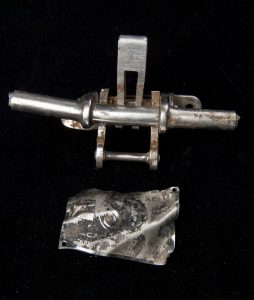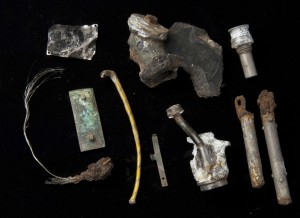At 15:20 on 5 September 1941, two Mark 1 spitfires collided over Edinburgh. Both aircraft crashed and one of them (X4560), piloted by Arthur Wescome Searle, from Rhodesia, dived into the garden of RBGE’s then curator, Roland Edgar Cooper. The pilot bailed out but was sadly killed as his parachute failed to open in time. He is buried in Dirleton cemetery in East Lothian.
Jimmy Ratter, who in 2011 celebrated his 50th year at RBGE, recalls standing in his grandparents garden as a seven-year-old boy watching a total of 12-16 spitfires flying low over Edinburgh just before the crash.
An excavation was organised by RBGE staff, with a team from the Dumfries and Galloway Aviation Museum, after the location of the crash was pinpointed by Pauline Scott who, as a young girl, was playing in a tent with a friend in her back garden. She recalled how she “peered out of the flaps of the tent and was horrified to see this shape hurtling towards me… the plane thankfully hit the ground on the other side of the high stone wall.” The excavation took place in July 2010, as an ideal opportunity arose from the temporary RBGE shop, which had been on this site, being moved as the John Hope Gateway opened.
No large pieces of the aircraft remained; however there were some interesting finds, including airframe and engine parts, cockpit Perspex, armoured glass and the stainless steel cockpit catch that was the last thing Pilot Officer Searle operated before leaving the aircraft.
Research by RBGE staff have found that Spitfire X4560 went into service in September 1940 and was involved in combat sorties as part of 609 squadron during the Battle of Britain. While being flown by Pilot Officer John Bisdee on 7th October 1940, X4560 shot down a Messerschmitt Bf110 near Portland. It was damaged in operations on 8th November 1940 and was repaired, eventually ending up based with 123 squadron at Drem in 1941.
This panel marks the location of this interesting, if slightly different, piece of Botanics history.
To find out more about the Dumfries and Galloway Aviation Museum please visit their website


